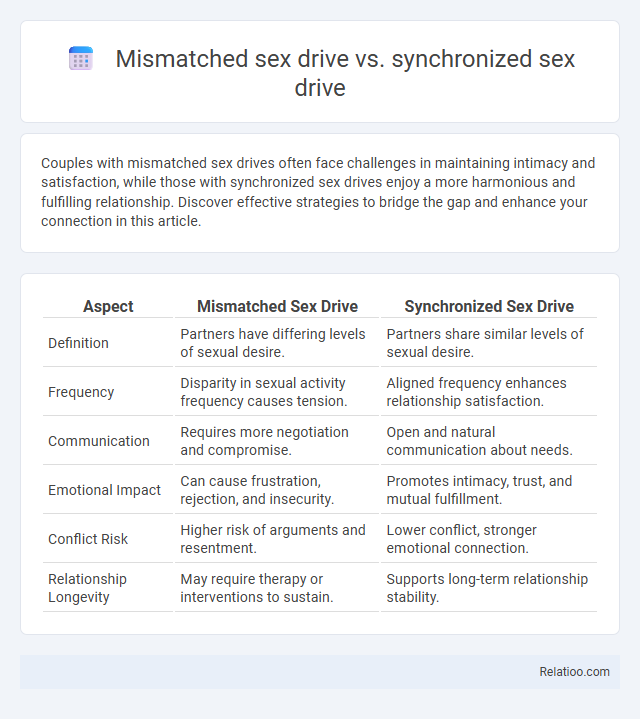Couples with mismatched sex drives often face challenges in maintaining intimacy and satisfaction, while those with synchronized sex drives enjoy a more harmonious and fulfilling relationship. Discover effective strategies to bridge the gap and enhance your connection in this article.
Table of Comparison
| Aspect | Mismatched Sex Drive | Synchronized Sex Drive |
|---|---|---|
| Definition | Partners have differing levels of sexual desire. | Partners share similar levels of sexual desire. |
| Frequency | Disparity in sexual activity frequency causes tension. | Aligned frequency enhances relationship satisfaction. |
| Communication | Requires more negotiation and compromise. | Open and natural communication about needs. |
| Emotional Impact | Can cause frustration, rejection, and insecurity. | Promotes intimacy, trust, and mutual fulfillment. |
| Conflict Risk | Higher risk of arguments and resentment. | Lower conflict, stronger emotional connection. |
| Relationship Longevity | May require therapy or interventions to sustain. | Supports long-term relationship stability. |
Understanding Mismatched vs Synchronized Sex Drives
Mismatched sex drive occurs when partners have differing levels of sexual desire, leading to potential frustration and relationship strain, while synchronized sex drive refers to partners sharing a similar frequency and intensity of sexual interest, fostering greater intimacy and satisfaction. Understanding mismatched versus synchronized sex drives involves recognizing the impact of biological, psychological, and relational factors that influence sexual desire alignment. Effective communication, empathy, and sometimes professional guidance can help couples navigate and reconcile desire discrepancies to maintain emotional connection and sexual fulfillment.
Causes of Variations in Sexual Desire
Variations in sexual desire can stem from mismatched sex drives, where partners experience different levels of libido, or synchronized sex drives, reflecting aligned desires that promote mutual satisfaction. Desire discrepancy often arises from psychological, hormonal, or relational factors such as stress, health conditions, or emotional disconnects, affecting Your intimate connection. Understanding these causes helps address mismatched or discrepant sexual desires by fostering communication and targeted interventions.
Impact of Mismatched Sex Drive on Relationships
Mismatched sex drives often lead to frustration, emotional distance, and decreased intimacy between partners, affecting relationship satisfaction and stability. In contrast, synchronized sex drives tend to promote mutual understanding, increased bonding, and a more fulfilling sexual connection. Desire discrepancy, when unaddressed, can cause communication breakdowns and resentment, highlighting the importance of open dialogue and empathy in maintaining relationship health.
Benefits of Synchronized Sex Drive
Synchronized sex drive enhances intimacy and relationship satisfaction by aligning partners' sexual needs and rhythms, reducing conflicts and misunderstandings related to desire. Your emotional connection deepens when both partners experience compatible levels of sexual interest, fostering mutual pleasure and trust. This harmony supports better communication, emotional bonding, and overall relationship stability.
Communication Strategies for Different Sex Drives
Effective communication strategies for mismatched or synchronized sex drives involve openly expressing desires and boundaries to foster mutual understanding. You can utilize active listening and empathy to address desire discrepancy without judgment, creating a safe space for emotional honesty. Tailoring conversations to reflect each partner's unique sex drive promotes intimacy and resolves conflicts stemming from differing levels of sexual desire.
Emotional Effects of Sexual Desire Differences
Emotional effects of sexual desire differences often include feelings of frustration, rejection, and decreased intimacy, impacting relationship satisfaction. You may experience anxiety or self-doubt when faced with mismatched sex drive, while synchronized sex drive generally fosters emotional closeness and mutual understanding. Desire discrepancy can lead to communication challenges and emotional distress, highlighting the importance of addressing sexual expectations openly.
Navigating Intimacy with Mismatched Drives
Navigating intimacy with mismatched sex drives requires open communication strategies that address desire discrepancies between partners, promoting emotional connection despite asynchronous libido cycles. Effective approaches include scheduling intimacy to align sexual responsiveness and exploring alternative forms of physical closeness to maintain relationship satisfaction. Understanding desire synchronization helps couples adapt to fluctuating sexual needs while fostering mutual respect and reducing frustration in intimate dynamics.
Solutions for Bridging Sex Drive Gaps
Bridging sex drive gaps involves open communication, understanding individual needs, and exploring compromises tailored to both partners' libido levels. Couples therapy, sex therapy, and mindfulness practices can enhance emotional intimacy and align desire, helping Your relationship thrive despite mismatched or synchronized sex drives. Regularly adjusting expectations and prioritizing mutual satisfaction transforms desire discrepancy into a source of connection rather than conflict.
When to Seek Professional Help
Seek professional help when mismatched sex drives or desire discrepancies cause persistent emotional distress, relationship conflicts, or communication breakdown. Couples experiencing ongoing frustration or withdrawal should consult a licensed sex therapist or counselor specializing in sexual health. Early intervention supports developing effective strategies to improve intimacy and align sexual expectations.
Building a Fulfilling Sexual Relationship
Understanding the difference between mismatched sex drive, synchronized sex drive, and desire discrepancy is crucial for building a fulfilling sexual relationship. Mismatched sex drive occurs when partners have differing levels of sexual interest, while synchronized sex drive means both partners share similar sexual desires, fostering harmony. Addressing desire discrepancy with open communication and empathy helps you navigate differences and strengthen intimacy.

Infographic: Mismatched sex drive vs Synchronized sex drive
 relatioo.com
relatioo.com